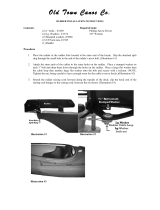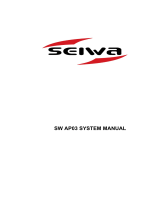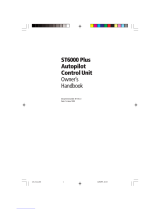Page is loading ...

Distributed by
Any reference to Raytheon or
RTN in this manual should be
interpreted as Raymarine.
The names Raytheon and RTN
are owned by the
Raytheon Company.

ST6001+
Autopilot
Control Unit
Owner’s
Handbook
Document number: 81190-2
Date: May 2001

ii ST6001+ Autopilot Control Unit - Owner’s Handbook
Autohelm, HSB (High Speed Bus), SailPilot, SeaTalk and SportPilot
are registered trademarks of Raymarine Ltd.
Raymarine, AST (Advanced Steering Technology), AutoAdapt,
AutoLearn, AutoRelease, AutoSeastate, AutoTack, AutoTrim,
FastTrim, GyroPlus, RayGyro, RayPilot and WindTrim are
trademarks of Raymarine Ltd.
Handbook contents © Raymarine Ltd 2001.

Preface iii
Contents
About this handbook ......................................................... vii
Important Information ..................................................... viii
Warranty ...................................................................................viii
Safety notices ...........................................................................viii
EMC conformance .....................................................................ix
Handbook information ...............................................................ix
Chapter 1: Introduction ............................................................1
Chapter 2: Basic Operation .......................................................3
2.1 Using the control unit ................................................................ 4
Start-up mode ............................................................................ 4
Keypad functions ...................................................................... 4
Display layout ........................................................................... 5
2.2 Using Auto mode ......................................................................6
Engaging the autopilot (Auto mode) ......................................... 6
Disengaging the autopilot (Standby mode) .............................. 6
Changing course in Auto mode ................................................. 7
Adjusting performance – Type 150G/400G ............................. 7
Adjusting performance – Types 150/400 and 100/300 .............8
Off Course warning ................................................................. 10
Dodging obstacles and then resuming course .........................10
Using sail boat features ...........................................................12
2.3 Adjusting display/keypad lighting ......................................... 14
Chapter 3: Advanced Operation ............................................15
3.1 Using Track mode ................................................................... 16
Selecting Track mode ............................................................. 16
Exiting Track mode .................................................................17
Cross track error ...................................................................... 17
Tidal stream compensation ..................................................... 18
Waypoint arrival and advance .................................................19
Waypoint Advance warning – summary ................................. 20
Dodges in Track mode ............................................................21
Safety in Track mode .............................................................. 22
3.2 Using Wind Vane mode – sail boats ........................................23
About Wind Vane mode .......................................................... 23
Selecting Wind Vane mode ..................................................... 24
Exiting Wind Vane mode ........................................................24
Adjusting the locked wind angle .............................................24

iv ST6001+ Autopilot Control Unit - Owner’s Handbook
Returning to the previous wind angle (LAST WND) ............. 25
Dodges in Wind Vane mode .................................................... 25
Wind Shift warning ................................................................. 26
Using AutoTack in Wind Vane mode ...................................... 26
Operating hints for Wind Vane mode ...................................... 27
3.3 Adjusting the rudder gain ........................................................ 27
3.4 Displaying data pages ............................................................. 29
Watch timer ............................................................................. 30
Warning messages .................................................................. 31
Chapter 4: Fault Finding & Maintenance ..............................33
4.1 Fault finding ............................................................................34
Common autopilot problems .................................................. 34
Autopilot alarm messages ....................................................... 35
4.2 General maintenance .............................................................. 37
Routine checks ........................................................................ 37
Cleaning the display ................................................................ 37
EMC advice ............................................................................37
4.3 Product support ....................................................................... 38
Chapter 5: Installing the ST6001+ ..........................................43
5.1 Select the location ................................................................... 44
Site requirements .................................................................... 44
5.2 Control unit installation .......................................................... 47
Surface mount control units .................................................... 47
Flush mount control units .......................................................48
5.3 SeaTalk connections ............................................................... 49
5.4 NMEA connections ................................................................ 50
Receiving NMEA data ............................................................ 50
5.5 Functional test – repeater units only ....................................... 53
Chapter 6: Commissioning the Autopilot ............................55
6.1 Dockside Checks .................................................................... 56
Step 1 - Switch on ................................................................... 56
Step 2 - Check the SeaTalk and NMEA connections .............. 57
Step 3 - Check the autopilot operating sense ........................... 58
Step 4 - Adjust basic autopilot settings ................................... 59
6.2 Seatrial Calibration ................................................................. 63
Calibrating the compass .......................................................... 64
Adjusting autopilot settings .................................................... 68

Preface v
Chapter 7: Adjusting Autopilot Settings ..............................75
7.1 Calibration basics ....................................................................76
Calibration groups .................................................................. 76
Accessing the Calibration mode .............................................78
7.2 Display Calibration ................................................................ 79
Display Calibration screens .................................................... 79
7.3 User Calibration ......................................................................83
User Calibration screens ......................................................... 83
7.4 Seatrial Calibration ................................................................. 87
7.5 Dealer Calibration ...................................................................88
Accessing Dealer Calibration ................................................. 88
Dealer Calibration screens and settings .................................. 88
Dealer Calibration defaults: Types 150/150G & 400/400G ...97
Dealer Calibration options: Types 150/150G & 400/400G ....98
Appendix: Using the ST6001+
With Non-150/400 Autopilots .............................................99
Using the autopilot (non-150/400 systems) ............................100
Commissioning the autopilot (non-150/400 systems) ............101
Dockside Checks .................................................................. 101
Seatrial Calibration ............................................................... 101
Calibration mode (non-150/400 systems) ...............................102
Calibration groups ................................................................ 102
Dealer Calibration screens .................................................... 104
Dealer Calibration: possible settings with Type 100/300 ..... 110
Specifications .....................................................................111
ST6001+ control unit ..............................................................111
Course computer functions .....................................................111
Glossary ..............................................................................112
Index ....................................................................................115

Preface vii
About this handbook
Welcome to the handbook for the ST6001+ autopilot control unit.
This handbook contains two main parts:
Part 1: Using the ST6001+
Part 2: Installing the ST6001+
At the end of this handbook we have included an appendix, product
specifications, a glossary, an index, installation templates, and
warranty information.
Note: This handbook contains important information about
installing, using and maintaining your new Raymarine product. To
get the best from the product, please read this handbook thoroughly.
1
Chapter 1: Introduction
Introduces the autopilot, its features and its use.
page 1
2
Chapter 2: Basic Operation
Covers basic autopilot operation: using Auto mode,
adjusting autopilot performance, and changing the control
unit lighting.
page 3
3
Chapter 3: Advanced Operation
Explains how to use Track and Wind Vane modes, adjust
rudder gain and display data pages.
page 15
4
Chapter 4: Fault Finding & Maintenance
Provides general maintenance procedures and
trouble-shooting information (including alarm messages).
page 33
5
Chapter 5: Installing the ST6001+
Explains how to install your ST6001+ control unit and
connect it to your autopilot system.
page 43
6
Chapter 6: Commissioning the Autopilot
Covers dockside checks after installation, and the initial
seatrial calibration.
page 55
7
Chapter 7: Adjusting Autopilot Settings
Provides details on adjusting the control unit and autopilot
settings in Calibration mode.
page 75

viii ST6001+ Autopilot Control Unit - Owner’s Handbook
Important Information
Warranty
To register your new Raymarine product, please take a few minutes to
fill out the warranty card. It is important that you complete the owner
information and return the card to us to receive full warranty benefits.
Safety notices
WARNING: Product installation
This equipment must be installed and operated in accordance
with the instructions contained in this handbook. Failure to do so
could result in poor product performance, personal injury
and/or damage to your boat.
WARNING: Electrical safety
Make sure the power supply is switched off before you make any
electrical connections.
WARNING: Calibration
We supply this product calibrated to default settings that should
provide initial stable performance for most boats. To ensure
optimum performance on your boat, you must complete Chapter
6: Commissioning the Autopilot before use.
WARNING: Navigation aid
Although we have designed this product to be accurate and
reliable, many factors can affect its performance. As a result, it
should only be used as an aid to navigation and should never
replace common sense and navigational judgement. Always
maintain a permanent watch so you can respond to situations as
they develop.
Your Raymarine autopilot will add a new dimension to your boating
enjoyment. However, it is the skipper’s responsibility to ensure the
safety of the boat at all times by following these basic rules:
• Ensure that someone is present at the helm AT ALL TIMES, to
take manual control in an emergency.

Preface ix
• Make sure that all members of crew know how to disengage the
autopilot.
• Regularly check for other boats and any obstacles to navigation –
no matter how clear the sea may appear, a dangerous situation can
develop rapidly.
• Maintain an accurate record of the boat’s position by using either
a navigation aid or visual bearings.
• Maintain a continuous plot of your boat’s position on a current
chart. Ensure that the locked autopilot heading will steer the boat
clear of all obstacles. Make proper allowance for tidal set – the
autopilot cannot.
• Even when your autopilot is locked onto the desired track using a
navigation aid, always maintain a log and make regular positional
plots. Navigation signals can produce significant errors under
some circumstances and the autopilot will not be able to detect
these errors.
EMC conformance
All Raymarine equipment and accessories are designed to the best
industry standards for use in the recreational marine environment.
The design and manufacture of Raymarine equipment and
accessories conform to the appropriate Electromagnetic
Compatibility (EMC) standards, but correct installation is required to
ensure that performance is not compromised.
Handbook information
To the best of our knowledge, the information in this handbook was
correct when it went to press. However, Raymarine cannot accept
liability for any inaccuracies or omissions it may contain. In addition,
our policy of continuous product improvement may change
specifications without notice. As a result, Raymarine cannot accept
liability for any differences between the product and the handbook.

Chapter 1: Introduction 1
1 Introduction
Chapter 1: Introduction
The Raymarine ST6001 Plus (ST6001+) is a SeaTalk
®
compatible
autopilot control unit. It is designed as the main control unit for
Raymarine Type 150, 150G, 400 and 400G course computers.
The ST6001+ control unit has the following modes:
1.
Standby: autopilot off (see page 6)
2.
Auto: autopilot steers the boat to maintain a locked heading
(see page 6)
3.
Track: autopilot steers the boat to maintain a track between two
waypoints created on a navigation aid (see page 16)
4.
Wind Vane: autopilot steers the boat to maintain a course relative
to a true or apparent wind angle (see page 23)
5.
Calibration: so you can adjust the autopilot to give optimum
performance for your boat (see page 76). This includes automatic
compass deviation correction (all autopilots) and AutoLearn
automatic steering calibration (Type 150G/400G systems only)
The ST6001+ also provides:
• automatic tack (AutoTack) in Auto and Wind Vane modes
• Northerly/Southerly heading compensation
• waypoint advance feature in Track mode
D5460-1

2 ST6001+ Autopilot Control Unit - Owner’s Handbook
1 Introduction
Functions with Type 150/150G and 400/400G autopilots
The functions provided with Type 150/150G and Type 400/4000G
autopilots depend on whether the course computer contains an
internal GyroPlus yaw sensor:
Extended systems
You can connect the ST6001+ to other Raymarine SeaTalk
equipment so it can send and receive SeaTalk data:
• it can use wind information from a SeaTalk wind instrument for
Wind Vane steering
• it can use waypoint information from a SeaTalk navigation
instrument to provide track control
• it can use boat speed from a SeaTalk speed instrument to optimize
track-keeping performance
You can also use the ST6001+ autopilot with any navigator
(GPS, Decca, Loran) or wind instrument that transmits National
Marine Electronics Association (NMEA) 0183 data.
The ST6001+ can display SeaTalk and NMEA instrument data in a
user-defined selection of data pages. When you are using the
ST6001+ to repeat instrument data, it shows a ‘pop-up’ pilot page for
5 seconds whenever you make a change in autopilot control.
Compatibility with other autopilots
The ST6001+ is also compatible with Raymarine Type 100 and
Type 300 course computers (see the Appendix for more details).
You can also use it as an additional repeater control unit for any
SeaTalk autopilot system, allowing autopilot control from a
secondary location.
Type 150G/400G (with GyroPlus) Type 150/400 (without GyroPlus)
Internal GyroPlus yaw sensor provides
enhanced course keeping using AST
(Advanced Steering Technology)
Full basic functionality: uses Raymarine
steering algorithm without AST
Improved track-keeping Improved track-keeping
Steering to true and apparent wind in
Wind Vane mode
Steering to true and apparent wind in
Wind Vane mode
Improved calibration access, including
AutoLearn (self-learning calibration)
Improved calibration access, but
without AutoLearn

Chapter 2: Basic Operation 3
2 Basic Operation
Chapter 2: Basic Operation
The sections in this chapter explain how to use the basic functions on
your ST6001+ autopilot control unit:
Note: If you are using the control unit with a non-150/400 autopilot
system, refer to the notes in the Appendix.
2.1
Using the control unit
Summarizes the key functions and screen layout on the
ST6001+ control unit.
page 4
2.2
Using Auto mode
Provides instructions for engaging/disengaging the
autopilot, using Auto mode and adjusting the
autopilot’s performance.
page 6
2.3
Adjusting display/keypad lighting
Explains how to change the lighting on the control unit
display and keypad.
page 14

4 ST6001+ Autopilot Control Unit - Owner’s Handbook
2 Basic Operation
2.1 Using the control unit
Start-up mode
The autopilot always powers up in Standby mode with the display
showing the boat’s current compass heading.
Note: You can press
standby at any time to return to manual
steering.
Keypad functions
The autopilot is controlled using simple push-button operations, all of
which are confirmed with a short beep. In addition to the main
single-key functions, there are several dual key operations.
TRACK
Press for Track
mode from Auto
(if a navigator is
connected)
Press to accept
waypoint advance
Press for 1 second
to skip waypoint
AUTO
Press for Auto mode
Press for 1 second
for Last Heading
Press again to
accept Last Heading
DISP
Press to display
data pages
Press for 1 second
for lamp control
STANDBY
Press for
Standby mode
Press for 2 seconds
to enter Calibration mode
Course change keys
Port 1˚ Starboard 1˚
Port 10˚ Starboard 10˚
STANDBY plus AUTO
Press for Wind Vane mode
(if a wind vane is connected)
Press for 1 second for Last Wind
Press again to accept Last Wind
-1 plus +1
Press for Response level
Press for 1 second
for Rudder Gain
+1 plus +10
Press together
for AutoTack
to starboard
-1 plus -10
Press together
for AutoTack
to port
D5449-1

Chapter 2: Basic Operation 5
2 Basic Operation
Display layout
The ST6001+ display screen provides the following information:
The bar graph at the bottom of the screen is normally a rudder position
indicator. This indicates the current position of the rudder, as
measured by the rudder position sensor.
Note: You can change this to a heading/cross track/wind error bar in
Display Calibration, see page 79.
Rudder position indicator or error bar
Port and Starboard
direction-to-steer
indicators
Autopilot mode
indicators
Distance units:
• no units = kilometres
• nm = nautical miles
• SM = statute miles
Heading indicators
Variable text region (up to 9 characters/digits)
D5457-1
Calibration mode
indicator (displayed on
calibration pages)

6 ST6001+ Autopilot Control Unit - Owner’s Handbook
2 Basic Operation
2.2 Using Auto mode
CAUTION:
Before using Auto mode, make sure that the pilot has been
correctly commissioned.
Engaging the autopilot (Auto mode)
To engage the autopilot:
1. Steady the boat on the required heading.
2. Press
auto:
• in Auto mode, the display shows the locked autopilot heading
CAUTION:
Autopilot course control makes it easier to sail a boat, but it is
NOT a substitute for good seamanship. ALWAYS maintain a
permanent watch by the helm.
Disengaging the autopilot (Standby mode)
Press standby to disengage the autopilot:
• in Standby mode, the display shows the boat’s current compass
heading.
• the last heading is memorized and can be recalled (see page 11).
D3560-3
D3561-3

Chapter 2: Basic Operation 7
2 Basic Operation
Changing course in Auto mode
In Auto mode, use the -1 and -10 (port) and +1 and +10 (starboard)
keys to change the locked heading in steps of 1° or 10°. For example:
press
-10 three times for a 30° course change to port.
Adjusting performance – Type 150G/400G
The main way you can adjust the performance of Type 150G/400G
(GyroPlus) autopilot systems is by changing the response level. This
is the only user adjustment you should need to make to the autopilot
on a regular basis.
The response level controls the relationship between the autopilot’s
course keeping accuracy and the amount of helm/drive activity.
Type 150G and 400G autopilot systems have 9 levels of response:
• level 1 gives the least pilot activity to conserve power, but may
compromise short-term course-keeping accuracy
• levels 4 to 6 should give good course keeping under normal
operating conditions – with crisp, well controlled turns but
without being over-aggressive
• level 9 gives the tightest course keeping and greatest rudder
activity, but may lead to a rough passage in open waters as the
autopilot may ‘fight’ the sea
When you require extra tight course keeping (e.g. for pilotage in
confined and sheltered waters), increase the setting. If you want to
minimize drive activity and conserve battery power, decrease
the setting.
Port Starboard
oror
D3320-2
/






